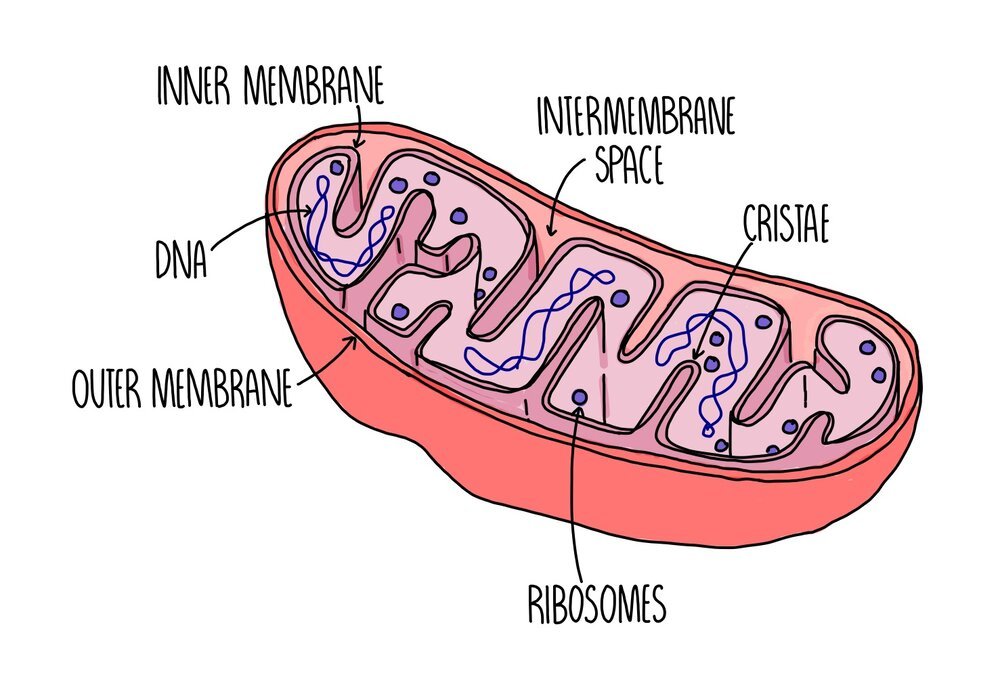Cell Structure and Microscopy
Ultrastructure of eukaryotic cells
All organisms are divided into two different domains: eukaryotes and prokaryotes. Eukaryotes include any organism whose cells contain a nucleus, while prokaryotes lack a nucleus and any other membrane-bound organelles.
GOLGI APPARATUS
Eukaryotic cells, such as the cells of animals, plants and fungi may contain the following organelles:
MITOCHONDRION
CHLOROPLAST
Nucleus - contains DNA which controls the activities of the cell by containing the base sequences (the ‘instructions’ needed to make proteins. The DNA is associated with histone proteins and referred to as chromatin which is wound into structures called chromosomes.
Nucleolus - this is a region within the nucleus where ribosomes are made.
Nuclear envelope - a double membrane which surrounds the nucleus. It contains pores which allows small molecules (like single stranded RNA) to pass into the cytoplasm but keeps hefty chromosomes safely inside its walls.
Rough endoplasmic reticulum (RER) - the RER is an extension of the nuclear envelope and is coated with ribosomes. It facilitates protein synthesis by providing a large surface area for ribosomes. It then transports the newly synthesised proteins to the Golgi apparatus for modification.
Smooth endoplasmic reticulum (SER) - synthesises lipids including cholesterol and steroid hormones (such as oestrogen).
Golgi apparatus - made up of a group of fluid-filled membrane-bound flattened sacs surrounded by vesicles. It receives proteins from the RER and lipids from the SER. It modifies the proteins and lipids and repackages them into vesicles. The Golgi apparatus is also the site of lysosome synthesis.
Ribosomes - ribosomes are responsible for the translation of RNA into protein (protein synthesis). They either float freely in the cytoplasm or are stuck onto the rough endoplasmic reticulum.
Mitochondria - site of ATP production during aerobic respiration. It is self-replicating so can become numerous in cells with high energy requirements. It contains a double membrane with folds called cristae, which provides a large surface area for respiration.
Lysosomes - phospholipid rings which contain digestive enzymes separate from the rest of the cytoplasm. Lysosomes engulf and destroy old organelles or foreign material.
Chloroplasts - the site of photosynthesis. It is enclosed by a double membrane and has internal thylakoid membranes arranged in stacks to form grana linked by lamellae. These structures are found only in plants and certain types of photosynthesising bacteria or protoctists.
Plasma membrane - consists of a phospholipid bilayer with additional proteins to serve as carriers. It also contains cholesterol to regulate membrane fluidity. The plasma membrane contains the cell contents and holds the cell together, whilst controlling the movement of substances into and out of the cell.
Centrioles - these are bundles of microtubules which form spindle fibres during mitosis in order to pull sister chromatids apart. They are also important for the formation of cilia and flagella. They are not found in plant and bacterial cells.
Cell wall - a rigid structure made of cellulose (in plants), chitin (in fungi) and murein (in prokaryotes) which provide support to the cell.
Flagella - a tail-like structure which are made up of bundles of microtubules. The microtubules contract to make the flagellum move and propel the cell forward. Cells with a flagellum include sperm cells, which use it to swim up the fallopian tubes to fertilise the egg cell.
Cilia - finger-like projections found on the surface of some cells. These also contain bundles of microtubules which contract to make the cilia move. Cilia are found on epithelial cells lining the trachea and move to sweep mucus up the windpipe.
Vacuole - the vacuole is an organelle which stores cell sap and may also store nutrients and proteins. It helps to keep plant cells turgid. Some vacuoles can perform a similar function to lysosomes and digest large molecules.
Protein production
Translation of mRNA into a polypeptide chain takes place on ribosomes which are either floating alone in the cytoplasm or attached to the rough ER.
The long polypeptide chain is folded at the rough ER and transported to the Golgi apparatus inside vesicles.
At the Golgi, they are modified and processed by various enzymes. The protein may have a carbohydrate chain stuck onto its surface, or the addition of a sulfate or phosphate group.
It is packaged inside another vesicle which travels to the part of the cell where the protein is needed. If the protein is a carrier protein, the vesicle will deliver the protein to the plasma membrane where it will be incorporated.
Cytoskeleton
The cytoskeleton is a network of protein threads that run through the cytoplasm. In eukaryotes, the protein threads are arranged as microfilaments and microtubules which support the cell’s organelles and keep them in position. When organelles and chromosomes move around the cell (i.e. during cell division), they do so by attaching and moving along the microtubules. The cytoskeleton also helps strengthen the cell and maintain its shape and it is responsible for the movement of cilia and flagella.
Comparing eukaryotic and prokaryotic cells
Prokaryotes and eukaryotes share some of the same organelles (cytoplasm, cell membrane, ribosomes) but there are some important differences:
Prokaryotes have no membrane-bound organelles (so no mitochondria, Golgi, endoplasmic reticulum, nucleus etc.). Their DNA floats freely in the cytoplasm.
Their DNA consists of a single circular chromosome whereas DNA in eukaryotes is linear and wrapped around chromosomes.
Prokaryotes have extra bits of DNA in the form of small circular plasmids.
Prokaryotes have smaller ribosomes (70S) compared to eukaryotic ribosomes (80S).
Eukaryotes like plants and fungi have cell walls made of cellulose and chitin. Bacterial cell walls are made of murein (a type of glycoprotein).
Prokaryotic cells are much smaller than eukaryotic cells.
Both prokaryotes and eukaryotes can have flagella but those found in prokaryotes are made of a protein called flagellin whereas in eukaryotes they are formed from microtubules.
Prokaryotes have some organelles that are absent from eukaryotic cells. These include:
Pili - pili are hair-like structures which stick out from the plasma membrane. They are used to communicate with other cells (including the transfer of plasmids between bacteria).
Mesosomes - the mesosome is a folded portion of the inner membrane. While some scientists believe that it plays a role in chemical reactions, such as respiration, other scientists doubt whether it even exists and think that it may just be an artefact produced during the preparation of bacterial samples for microscopy.
Plasmids - plasmids are small, circular rings of DNA which are separate from the main chromosome. They house genes which are not crucial for survival but might prove useful - such as antibiotic-resistance genes, for example. Plasmids can replicate independently from the main chromosomal DNA.
Slime capsule - in addition to a cell wall, some bacteria also have a capsule which is made of slime. The main function of the capsule is to protect the bacterium against an immune system attack.
Microscopy
LIGHT MICROSCOPE
The light microscope uses light to magnify objects up to 1,500x their actual size. They have a resolution of approximately 0.2 μm which isn’t large enough to visualise any of the smaller organelles, such as ribosomes and lysosomes. They are more commonly used for visualising whole cells or tissues. An advantage of light microscopy is that it can visualise living cells so we can watch behaviours such as cell division in real time.
Laser scanning confocal microscopes are a special type of light microscope. They use laser beams to scan a specimen, which will be labelled with a fluorescent tag. When the laser beam hits the tag, it gives off light which is focused through a pinhole to a detector. The detector transmits the 3D image to a computer. Confocal microscopes produce clearer images than normal light microscopes and can be used to look at the specimen as different depths.
The transmission electron microscope (TEM) is more powerful than a light microscope and has a high enough resolution (around 0.0002 μm) to visualise individual organelles. A TEM uses electromagnets to focus a beam of electrons at a sample. Electrons have a much shorter wavelength compared to visible light which means higher-resolution, detailed images can be produced. A disadvantage of TEM is that the sample needs to be fixed and placed in a vacuum, which means that live cells cannot be used.
The scanning electron microscope (SEM) has a lower resolution (around 0.002 μm) than the TEM but they can produce 3D images of cells and organelles. They emit a beam of electrons towards a sample, knocking electrons off it which are used to build an image. Like TEMs, SEMs cannot be used with live cells. Both types of electron microscope are pretty big and expensive so you’ll only find them in specialised research facilities and hospitals.
| Light microscope | TEM | SEM | |
| Maximum magnification | 1,500 x | 1,000,000 x | 500,000 x |
| Maximum resolution | 0.2 um | 0.0002 um | 0.002 um |
Magnification
Magnification is how enlarged the image is compared to the original object. Resolution is defined as how well a microscope distinguishes between two points that are close together (i.e. how much detail it can make out). Light microscopes have a much lower resolution, so produce less detailed images, compared to electron microscopes.
You can work out the magnification of a specimen viewed under a microscope using the equation:
Let’s say we magnify a 2 μm bacterial cell to form an image which is 16 cm long. The magnification we must have used is:
Convert both into the same units. 16 cm = 160 mm = 160,000 μm
160,000 / 2 = 80,000 x magnification
Calibrating the eyepiece graticule and the stage micrometer
If you wanted to measure the size of your specimen, you’ll first need to align the eyepiece graticule and the stage micrometer which are little rulers which are found on the lens and the stage respectively. To do the calibration you need to carry out the following steps:
Place the stage micrometer on the stage and focus the lens so that you can clearly see the divisions.
Align the eyepiece graticule with the stage micrometer.
Each division of the stage micrometer is 0.1 mm. If the eyepiece graticule spans a total of three divisions, then we know that the total length of the eyepiece graticule is 0.2 mm.
The graticule is divided by a scale from 0 to 100, which means that each individual division is a length of 0.002 mm.
Now we can take away the stage micrometer and add our sample, using the eyepiece graticule to measure its size.
Viewing specimens under an optical microscope
Pipette a drop of water onto a microscope slide then place your specimen on top (this needs to be just a thin layer of cells so that light can pass through).
Add a drop of stain e.g. oesin stains the cell’s cytoplasm. This creates contrast and enables organelles to be visualised.
Add a cover slip to protect the specimen by carefully tilting and lowering down, taking care not to trap any air bubbles.
Place the slide onto the microscope stage and select the lowest-powered objective lens.
Look down the eyepiece and use the coarse adjustment knob to focus the specimen.
Select increasingly higher magnifications until you can visualise the cell structures you’re interested in.






